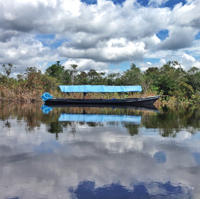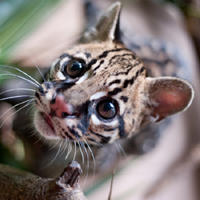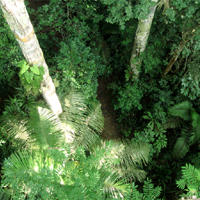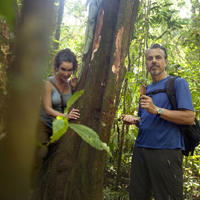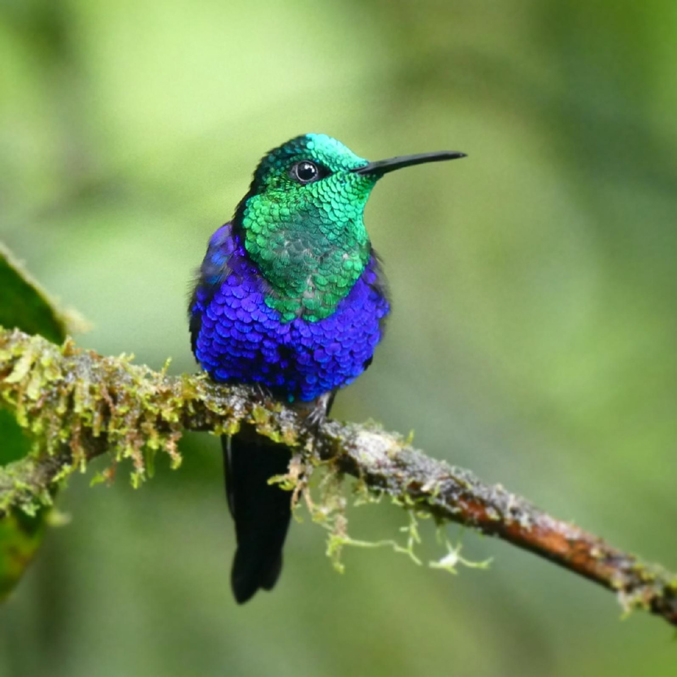
Crowned Woodnymph Hummingbird (Thalurania colombica). Photo by Noah Strycker / noahstrycker.com
The endangered Amazon rainforest is not just lovely and lush to look at—it’s critical to life as we know it. The region provides 20 percent of the world’s oxygen and 20 percent of its fresh water. Humans would feel the loss of that terribly, in real-world ways.
But it isn’t all about us.
The great Amazon basin, home to more than half the world's rainforests, is also home to millions of species—80,000 higher plants, 2.5 million insects, 1,500 birds, 430 mammals, 1,000 amphibians, 450 reptiles, 3,600 arachnid species (spiders!) and more than 5,600 freshwater fish—whose magnificent ecosystem is being destroyed. I first witnessed this while on plant trade expeditions with my husband, ethnobotanist Chris Kilham, and now, with Cosmic Sister advocacy work, I’m still seeing more of the same. For nearly a decade, I’ve watched barges laden with giant old growth trees pass us by on the river on the way to the timber market. I’ve seen thousands of acres of palm oil plantations, careless gold mining ravaging riverbeds and virtually every living creature for sale in the market—dead or alive. I believe that compassionate people can counteract this callous hostility towards nature. Our numbers are growing but we’re up against enormous, corrupt global powers—and we’re losing. We need more people to take a stand.
Being on the environmental frontline means bearing witness to the best and worst of what we’re capable of as a species. When my heart hurts, I meditate on the miracle of life in these interconnected rainforest beings, and their spirit medicine leaves me renewed, refreshed and inspired to keep up the fight.
My husband, the Medicine Hunter, travels the world searching for medicinal plants and develops sustainable, plant-based remedies that provide indigenous people with economic opportunities that also help to preserve their culture and the natural environment. “The rainforests provide medicinal plants, fruits, nuts and oils.” Chris says. “They’re much more valuable alive than clear-cut or burned.”
Chris is awed by the diversity and resilience of the Amazon, still home to the most plant species on Earth despite the human assault. “We should cherish rather than destroy this precious environment,” he says.
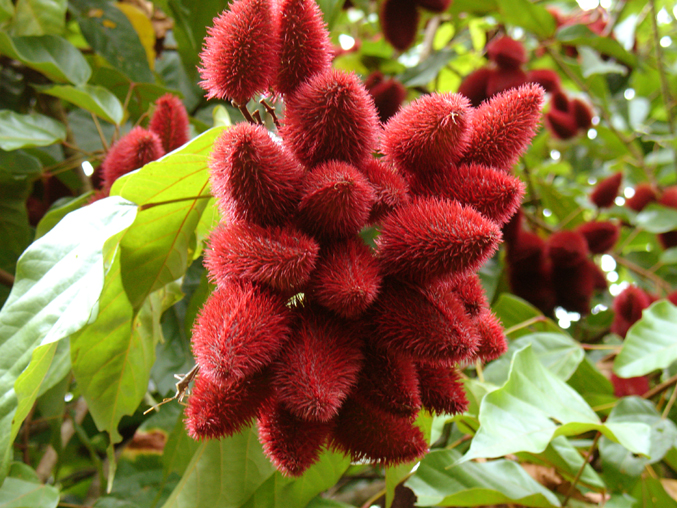
Annatto (Bixa orellana). Photo by Chris Kilham / medicinehunter.com
Medicinal plants from the Amazon, including cat’s claw, dragon’s blood and ayahuasca, provide scientifically proven health benefits, and more and more cosmetics include rainforest-derived ingredients. Probably the best-known example is annatto (Bixa orellana), a natural red dye in makeup and hair color that can replace potentially toxic industrial dyes.
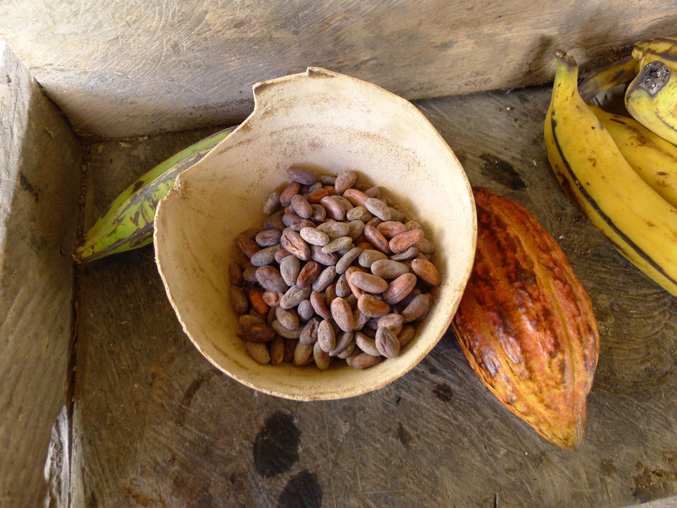
Cocoa (Theobroma cacao). Photo by Chris Kilham / medicinehunter.com
And what would life be without Theobroma cacao (literally means “food of the gods”) a sacred plant that originates from the Amazon? Cocoa is derived from this sensual rainforest plant—and we use it to make chocolate. Beyond the flavor that billions adore, cocoa is beneficial for health. “Cocoa, one of nature’s many miracles, is the healthiest food in the world,” Chris says. Research shows that cocoa can significantly benefit the cardiovascular system, reduce cognitive decline in old age, and enhance the natural production of serotonin and dopamine, the brain’s “feel-good chemicals.”
Medicines inspired by Amazon amphibians and insects also show a great deal of promise.
Amazonian bee propolis is a potent antimicrobial resin that bees make to protect their hives. “Propolis is yet one more tremendous skin protector,” Chris says. “Its resinous nature creates a thin barrier on wounds, providing anti-infective power and sealing the wound from further invasion.”
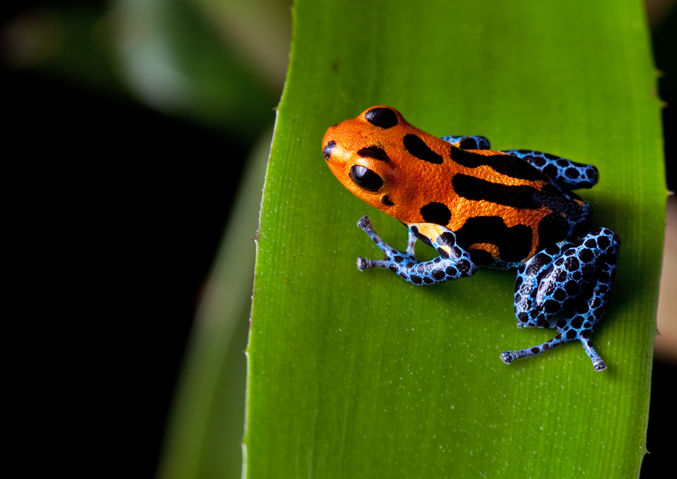
Red-backed Poison Dart Frog (Dendrobates tinctorius). Photo by Kikkerdirk / Can Stock Photo
And medical researchers have been studying amphibians like the brightly colored Amazonian red-backed poison dart frog (Dendrobates tinctorius) to synthesize venom in drug design, including use as a natural painkiller. Synthetic is critical in this case, so that no frogs are captured or bred and killed to make medicine.
In the rainforest, plants, insects and other pollinator species need each other to survive. If one specific insect is a plant’s only pollinator and the insect goes extinct—well, that’s extremely bad news for the plant. According to the Rainforest Foundation, deforestation can cause rainforest extinction rate to soar three or four times higher than the natural extinction rate of about one species per year. All sorts of critters are pollinators—including hummingbirds and butterflies.
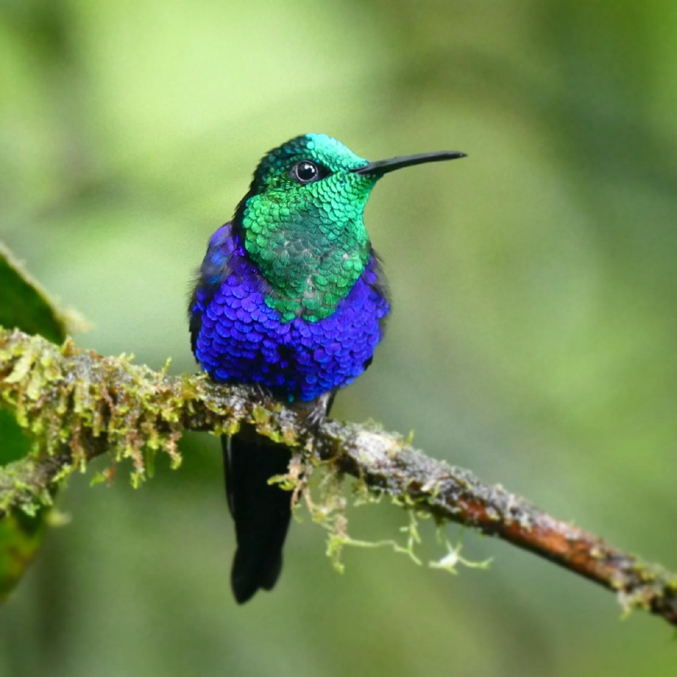
Crowned Woodnymph Hummingbird (Thalurania colombica). Photo by Noah Strycker / noahstrycker.com
Hummingbirds, which are considered to be divine messengers in Amazonian shamanic traditions, dine mostly on flower nectar and must consume half their body weight each day to survive. “Hummingbirds have inspired some of the best names in ornithology,” says photographer-adventurer Noah Strycker of National Audubon Society's Birding Without Borders, “What's not to love about a bird called a crowned woodnymph?”
Populations of the jewel-toned crowned woodnymph (Thalurania colombica)—which looks like a cross between a tiny dragon and a shimmering fairy spirit—have fallen by 30 percent over 10 years, the IUCN Red List of Threatened Species (iucnredlist.org) reports. Eco-tourism can help. Amazon Birding , for instance, provides wild sanctuary for 22 hummingbird species at the Hummingbird Garden in Peru.
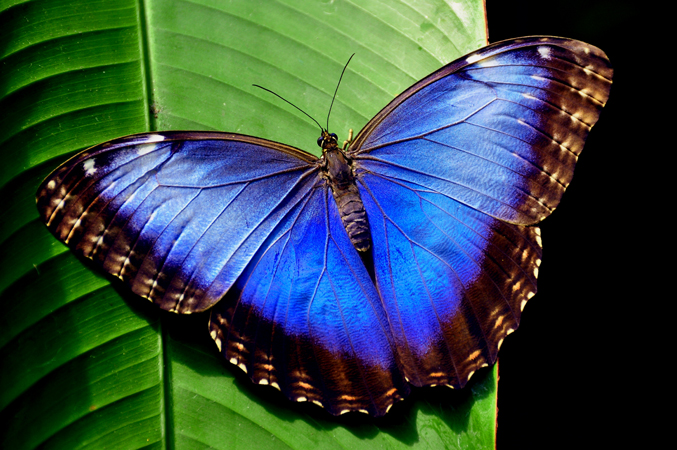
Blue Morpho Butterfly (Morpho peleides). Photo by Can Stock Photo
Of the 7,000 butterfly species in the Amazon, the Blue Morpho (Morpho peleides) stands out. With a wingspan from five to eight inches, it is one of the world’s largest butterflies. But size isn’t the thing. Camouflaged with shadow-toned eye spot patterns, the butterflies seem to disappear when their wings are closed but flash a brilliant iridescent blue—an affect created from microscopic scales that reflect sunlight—as they open their wings and fly. In the jungle, they appear to move in and out of the spirit realm. But deforestation, habitat fragmentation and collectors drawn to the butterflies’ otherworldly beauty are all threats.
Every year at the Sensational Butterflies exhibition’s hatchery, thousands of visitors watch blue morpho butterflies emerge from chrysalises under the expert care of lepidopterist Luke Brown, director of The Butterfly Gardener. “Metamorphosis is one of nature’s greatest wonders,” Brown says.
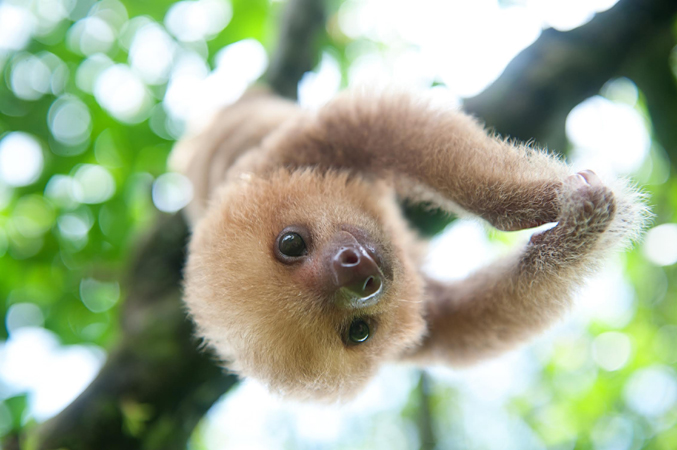
Baby Two-toed Sloth (Choloepus hoffmanni). Photo by Sam Trull / slothlove.com
The Amazon basin is also home to wonderful mammals, including funny little creatures like sloths, anteaters, giant river otters, capybaras (sort of a giant guinea pig) and the pigmy marmoset—the world’s smallest monkey at only 5 inches. Sam Trull, a wildlife rehabilitator and author of Slothlove, has raised many orphaned baby sloths. She studies and advocates for both the two-toed sloth (Choloepus hoffmanni) and three-toed sloth (Bradypus torquatus). “Sloths are such loving creatures,” she says, “They melt the hearts of all who see them.”
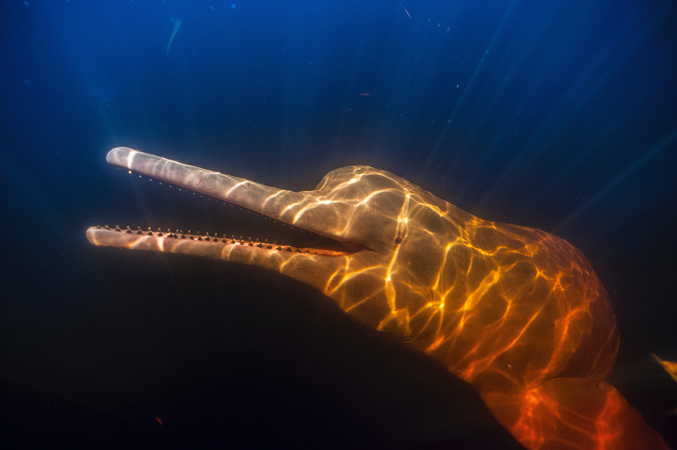
Amazon Boto Pink River Dolphin (Inia geoffrensis). © Doc White / naturepl.com
Two of the most mystical mammals of the Amazon are the beloved pink dolphins, known as the boto (Inia geoffrensis), and the lesser-known but equally endearing tucuxi (Sotalia fluviatilis), depend on healthy rivers to survive. Extractive industry such as logging, petroleum, gold mining and commercial fishing are all threats. Through his nonprofit Solinia, Cédric Gilleman teaches thousands of local children about wild dolphins—known as shapeshifters, or encantados—in their native habitat and asks them to pledge to help protect “their” dolphins and rivers.
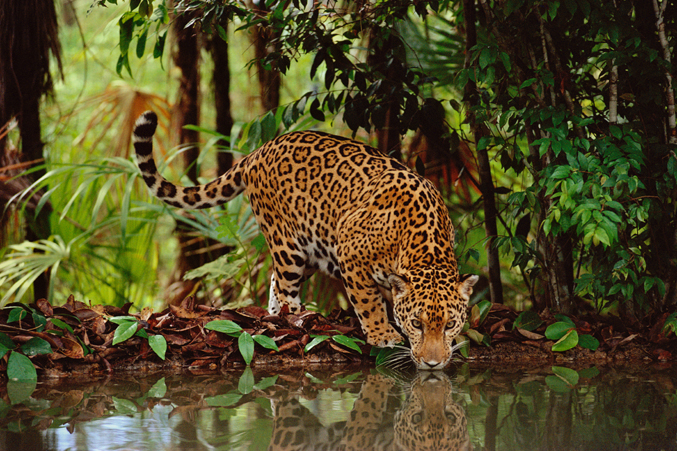
Jaguar (Panthera onca). Photo by Frans Lanting / lanting.com
Jaguars (Panthera onca), a major power animal in Amazonian shamanic tradition, once ranged as far as Northern California, but early European settlers wiped them out. During the 1960s and 1970s, as many as 18,000 jaguars were killed each year for their spectacular “rosette” spotted coats. In 1973, the Convention on the International Trade in Endangered Species attempted to stop pelt poaching, but it’s still all too common to see stacks of jaguar skins for sale in Amazonian markets. Deforestation and habitat fragmentation also threaten jaguars, which roam extensively and don’t recognize political borders.
Panthera creates corridors where wild cats can pass safely across 18 Latin American countries. “Their spirit is indeed indomitable, and it calls forth the same in us,” says Chief Development Officer Rebecca Bowen.
The black market pet trade is also a serious threat. “If you go to the market and ask for a pet orphaned jaguar cub, within a few days you will have one,” says Gudrun Sperrer, founder of the Pilpintuwasi Amazon Animal Orphanage in Peru. “But the cub will be an orphan because the hunter killed the baby's mother.”
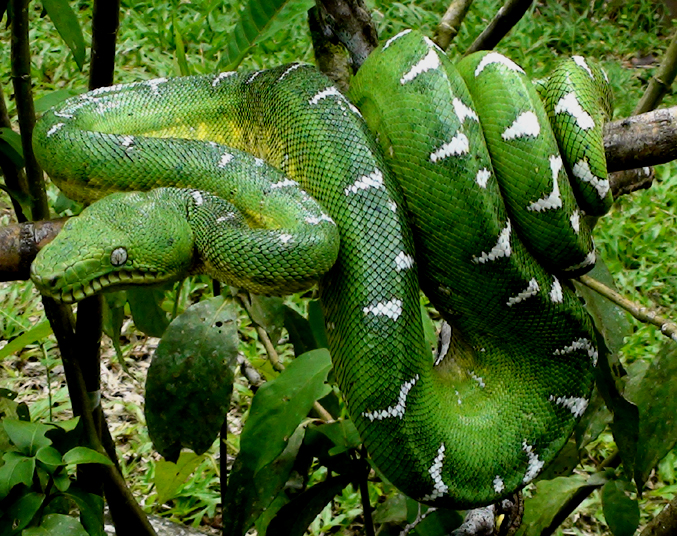
Amazon Basin Emerald Tree Boa (Corallus batesii). Photo by Zoe Helene / zoehelene.com
Amazon Basin emerald tree boas (Corallus batesii) can grow up 10 feet long and have remarkable “lightning bolt” zigzag color patterns. By day they’re docile, but at night they can become fierce predators with sophisticated heat sensors that scientists are studying for new ways of locating tiny tumors. Habitat destruction and the exotic pet and skin trade threaten snakes—though we don’t know how severely because their populations aren’t monitored, says Melissa Amarello, co-founder and education director for Advocates for Snake Preservation. “It's interesting that animals whom many would describe as hideous are traded in great numbers for skins and pets.”
Humans are the Amazon rainforest’s primary threat. Like a snake sheds its skin, we must shed cultural programing that leads to extractive and exploitative industries and move beyond this age of arrogance to take our position intelligent, noble stewards. The following simple choices can influence how our species evolves:
Choose natural products that support Amazon rainforests and indigenous people.
Do not buy into “sustainable palm oil” propaganda; there is no such thing.
Reduce meat consumption. Cattle ranching is responsible for up to 70 percent of deforestation in Brazil, the world’s second-largest beef exporter.
Be mindful when purchasing wood products, especially rosewood, mahogany and ebony, and be wary of wood products marketed as “exotic,” even if it they’re also labeled “sustainable.”
Boycott exotic animal products and exotic pets.
Buy jewelry with ethically sourced precious metals.
Consume fewer fossil fuels—70 percent of the Peruvian Amazon is leased by oil companies.
Donate to nonprofits that protect and defend the Amazon rainforest.
Most importantly, love deeply and courageously. Compassion, respect, humility and a sense of wonder remain key drivers in creating positive change.
* * * * * * * * * * * * * * * * * * END* * * * * * * * * * * * * * * * * *
ONLINE RESOURCES:
Cosmic Sister (cosmicsister.com) @cosmicsister
Zoe Helene (zoehelene.com) @zoehelene
Medicine Hunter (medicinehunter.com)
Rainforest Foundation (rainforestfoundation.org)
Audubon’s Birding Without Borders (audubon.org/noah)
IUCN Red List of Threatened Species (iucnredlist.org)
Amazon Birding (amazonbirding.com)
Sensational Butterflies (nhm.ac.uk)
The Butterfly Gardener (thebutterflygardener.co.uk)
Slothlove (slothlove.com)
Solinia (solinia.org)
CITES (trade.cites.org)
Panthera (panthera.org)
Pilpintuwasi Amazon Animal Orphanage (amazonanimalorphanage.org)
Advocates for Snake Preservation (snakepreservation.org)
Frans Lanting (lanting.com)
Noah Strycker (noahstrycker.com)
PHOTO CREDITS:
Image: Annatto (Bixa orellana). Photo by Chris Kilham / medicinehunter.com
Image: Cocoa (Theobroma cacao). Photo by Chris Kilham / medicinehunter.com
Image: Red-backed Poison Dart Frog (Dendrobates tinctorius). Photo by Kikkerdirk / Can Stock Photo
Image: Crowned Woodnymph Hummingbird (Thalurania colombica). Photo by Noah Strycker / noahstrycker.com
Image: Blue Morpho Butterfly (Morpho peleides). Photo by Can Stock Photo
Image: Two-toed Sloth (Choloepus hoffmanni). Photo by Sam Trull / slothlove.com
Image: Amazon Boto Pink River Dolphin (Inia geoffrensis). © Doc White / naturepl.com
Image: Jaguar (Panthera onca). Photo by Frans Lanting / lanting.com
Image: Amazon Basin Emerald Tree Boa (Corallus batesii). Photo by Zoe Helene / zoehelene.com
--END--
Multidisciplinary artist and environmental activist Zoe Helene (@zoehelene) is passionate about promoting and connecting kindred-spirit trailblazers in mutually supportive ways. Through Cosmic Sister (@cosmicsister) advocacy projects, she helps communicate messages of love, liberty, and informed pro-activism. Zoe is a devoted wildlife advocate and Woman of the Psychedelic Renaissance.
